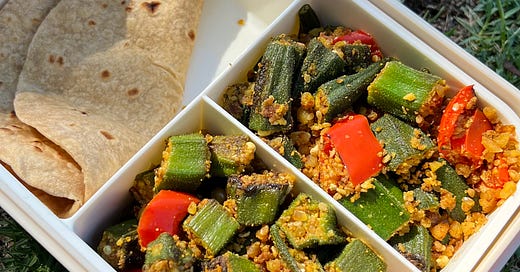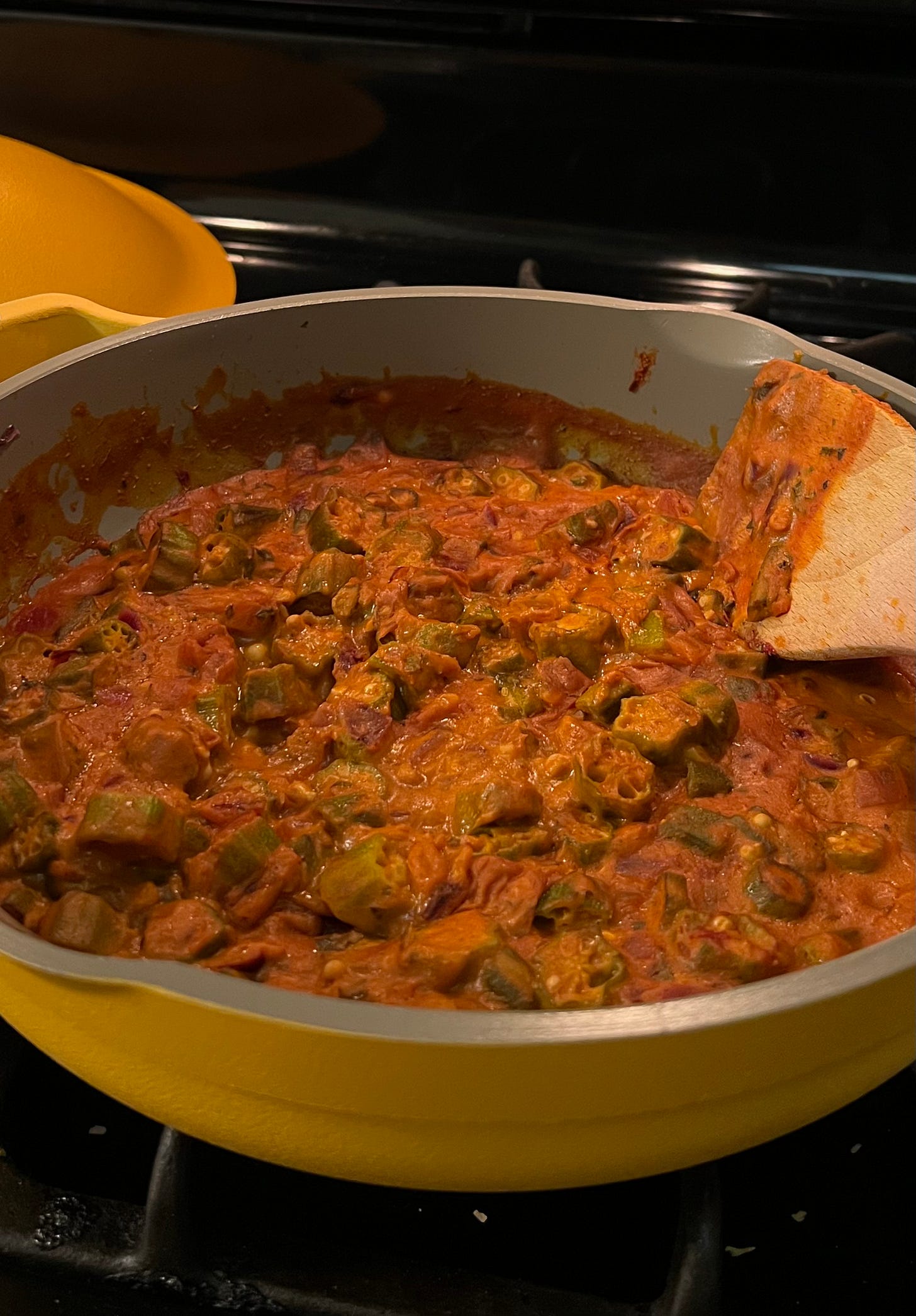Adults will ask you a lot of questions when you’re a kid. “What do you want to be when you grow up?” Pop star. Novelist. Police officer. Car saleswoman (this was a weird phase for me). They’ll ask you about your favorite place. Disneyland. The pond across the street. Home. Your favorite vegetable. Paneer, before I found out paneer is cheese…not a vegetable. Oops. Bhindi. Bhindi.
People who love bhindi (one of the many Indian names for okra) really love it. And people who hate it have probably had it once. I have always belonged to the former group. Slime or no slime, any okra at the table was mine. My little hands made their way to the green things on my dad’s plate because I wanted to eat everything he ate.
For a food to be your favorite, it doesn’t have to be what your taste buds enjoy the most or the best thing you’ve ever consumed. Memories and feelings are just as important. Although okra is divisive, it symbolizes universal satisfaction to me. My family has our fair share of food disagreements, but okra is one vegetable we consistently agree on. Knowing that this vegetable will consistently nourish and comfort us is part of our collective identity.
It’s interesting to consider the attitudes towards okra in different parts of the world. People love it in India, southeast Asia, Africa, parts of Europe, and the southern United States. But in the US, okra is often labeled as a “most hated” vegetable according to surveys. Its sliminess is usually cited as the reason why people don’t like it, even though it can be cleverly harnessed in thick stews like gumbo. Chris Smith brings up an interesting argument in Saveur:
Embrace the slime, I thought. Oysters are slimy and people pay good money to slurp those snot-balls from their shells, so why not 365-day fermented okra?
There is so much to celebrate about okra and its diverse culinary applications, but the conversation tends to return to slime. If getting past the texture is all it takes to convert haters into fans, let’s talk slime.
slime-free zone
Make sure your okra is as dry as possible. Use a towel to squeeze out excess moisture. Or leave it in the sun for some time! Frozen okra will be a bit more challenging, so make sure to pay attention to how moist it is before cooking.
Reduce contact between the pieces as they cook.
Salt the okra at the end. Salt draws out moisture and we don’t want that happening earlier than it needs to.
High heat. The science, as explained by Emily Horton for The Washington Post:
The okra cells break, the gel dissolves in the cells’ moisture, some of it evaporates — and it concentrates.
Now if the above didn’t work out for you…acid. Try lemon juice, lime juice, or vinegar, depending on what’s culturally appropriate in your dish. Tomatoes pair especially well with okra and the seasons coincide! The science:
Viscosity peaks at neutral to alkaline pH, which is why exposing okra to acidic ingredients, such as vinegar or tomatoes, tones it down. Some African cooks go in the other direction, adding baking soda (which raises pH to a more alkaline level) to okra soup to augment its thickening effect.
some recipes
The okra I eat most often is bhindi bhujia, which is lightly fried with mustard seeds, hing (asafetida), dry red chilis, and turmeric. My favorite way to eat it is probably as bhindi masala, where the onions are cooked until they appear almost caramelized, but any sweetness is masked with spices. A little amchur (dried mango powder) and garam masala give it a kick. These two recipes have long been a part of me, but there are so many ways to eat okra and I wanted to explore. Below you’ll find two very different Indian preparations of okra.
bhindi fry with peanuts and besan
A Gujarati shaak inspired by Sheil Shukla’s cookbook, Plant-Based India. His book has a recipe for a similar dish with bell peppers. The nutty combination of peanuts, besan (chickpea flour), and sesame seeds is so delightful and such an effective way to include some fat and protein in a vegetable dish. I saw a red poblano pepper at the farmers’ market and had to toss it in here.
Serves 2-3
¼ cup raw peanuts
2 tbsp besan (chickpea flour)
2 tbsp white sesame seeds
1 tbsp avocado oil or another neutral oil
¾ lb of bhindi (okra)
Optional: a medium red poblano pepper or bell pepper, cut into 1-inch pieces
Salt to taste
1 tsp ground coriander
½ tsp ground cumin
¼ tsp ground turmeric
¼-½ tsp red chili powder
Grind the peanuts until they are coarse. In a small bowl, combine the peanuts, besan, and sesame seeds. Toast in a pan over medium heat for 5-7 minutes until it is lightly browned. Stir occasionally to make sure it doesn’t burn. Take the mixture out of the pan and set it aside.
Wash the bhindi and cut it into ~ ¾-inch pieces. Thoroughly dry the bhindi with a towel.
Heat oil in the same pan. Add the bhindi and try to reduce contact between the pieces as much as possible. Let the pieces char on all sides. When the bhindi is almost cooked, add the peppers and let them soften a little, but I like mine to have a bite to it.
Add salt and the ground spices. Coat the bhindi in the spices. Add the peanut, besan, and sesame seed mixture. Stir for a few minutes. Add 2-3 tablespoons of water and continue cooking until it comes together!
dahi bhindi
Tender okra sits in an aromatic tangy dahi (yogurt) gravy. This is what I would consider “restaurant-style” bhindi since Indian restaurants are known for the thick orange gravies. If someone doesn’t like okra in this, give up on trying to convert them to an okra lover.
serves 2-4
¾ lb of bhindi (okra)
lime juice from half a lime
salt
2 tbsp of avocado oil or another neutral oil, divided
1 red onion, finely chopped
3 garlic cloves, minced
1 inch ginger, minced
3 tbsp canned tomato paste (or some fresh tomato paste!)
1 tsp ground coriander
½ tsp ground cumin
½ tsp turmeric
½ tsp red chili powder
½ cup unsweetened plant-based yogurt (I used cashew yogurt)
1 cup water
½ tsp kashmiri chili powder (optional for color)
½-1 tsp garam masala (amount depends on strength of garam masala)
1 tsp kasoori methi (dried fenugreek leaves)
Wash and cut bhindi into ½-inch pieces. Heat 1 tbsp oil in a medium pan over medium heat. Add the okra. Let it cook for about 10 minutes. About half way through, add a squeeze of lime juice. Finish with salt.
Heat 1 tbsp oil in the same pan or another pan over medium heat. Add the onion and cook for 5 minutes or until translucent. Add garlic and ginger. Cook for 2 minutes or until the raw smell dissipates.
Add tomato paste and a pinch of salt. Once the tomato paste has integrated well with the aromatics, add coriander, cumin, turmeric, and red chili powder. Then add yogurt. Stir for a few minutes until well-combined.
Add water and let it simmer until it has a nice thick texture. Finish with kashmiri chili, garam masala, and kasoori methi.
Enjoy with roti or a flatbread of your choice!
SPICE RACK
dishing on the favorites
cooking: I keep making the same sandwich for lunch. Hummus, tomatoes, tofu marinated in balsamic vinegar, and spring greens. Also aloo dum, yellow watermelon, and cold soba.
drinking: Water kefir! It’s a bit like kombucha, but without the caffeine. The passionfruit lemongrass from Kif Water Kefir serves up immaculate evening vibes.
reading: I’m Glad My Mom Died by Jennette McCurdy. And:
What if food were treated as a human right?
The Great Food Instagram Vibe Shift
listening: Wallows.






